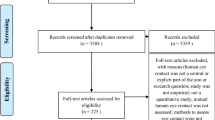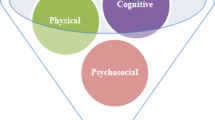Abstract
This study examined the effects of storytelling with or without contextual information on children with autism spectrum disorder (ASD) and typical development (TD) using eye-tracker. They were randomized into two groups—the stories included and did not include social contextual information respectively. Training was delivered in groups, with eight sessions across four weeks, 30 min/session. Participants’ fixation duration, visit duration, and fixation count on human faces from 20 photos and a video were recorded. Our findings revealed that storytelling with social contextual information enhanced participants’ eye gazes on eyes/ faces in static information (photos) for both children with ASD and TD, but the same advantage could not be seen for children with ASD in regard to dynamic information (videos).
Clinical Trial Registration Number (URL: http://www.clinicaltrials.gov): NCT04587557

Similar content being viewed by others
References
American Psychiatric Association. (2013). Diagnostic and statistical manual of mental disorders: DSM-5. (5th ed.). American Psychiatric Association.
Arango-Lasprilla, J. C., Rivera, D., Ramos-Usuga, D., Vergara-Moragues, E., Montero-López, E., Adana Díaz, L. A., Aguayo Arelis, A., García-Guerrero, C. E., García de la Cadena, C., Llerena Espezúa, X., Lara, L., Padilla-López, A., Rodriguez-Irizarry, W., Alcazar Tebar, C., Irías Escher, M. J., Llibre Guerra, J. J., Torales Cabrera, N., Rodríguez-Agudelo, Y., & Ferrer-Cascales, R. (2017). Trail making test: Normative data for the Latin American Spanish-speaking pediatric population. NeuroRehabilitation, 41(3), 627–637
Bader, R. (2006). Using Social Stories to increase emotion recognition and labeling in school-age children with autism. Unpublished doctoral dissertation, Alliant International University, California School of Professional Psychology, San Francisco.
Bialystok, E. (2010). Global-local and trail-making tasks by monolingual and bilingual children. Developmental Psychology, 46(1), 93–105
Chawarska, K., Macari, S., & Shic, F. (2013). Decreased spontaneous attention to social scenes in 6-month-old infants later diagnosed with autism spectrum disorders. Biological Psychiatry, 74(3), 195–203
Cilia, F., Aubry, A., Le Driant, B., Bourdin, B., & Vandromme, L. (2019). Visual exploration of dynamic or static joint attention bids in children with autistic syndrome disorder. Frontiers in Psychology. https://doi.org/10.3389/fpsyg.2019.02187
Csibra, G., & Gergely, G. (2006). Social learning and social cognition: The case for pedagogy. Attention and Performance XXI, 21, 249–274
Dugbartey, A. T., Townes, B. D., & Mahurin, R. K. (2000). Equivalence of the color trails test and trail making test in nonnative English-speakers. Archives of Clinical Neuropsychology, 15(5), 425–431
Enticott, P. G., Kennedy, H. A., Johnston, P., Rinehart, N. J., Tonge, B. J., Taffe, J. R., & Fitzgerald, P. B. (2014). Emotion recognition of static and dynamic faces in autism spectrum disorder. Cognition and Emotion, 28(6), 1110–1118
Feinberg, M. J. (2001). Using Social Stories to teach specific social skills to individuals diagnosed with autism. Unpublished doctoral dissertation, Alliant International University, California School of Professional Psychology, San Francisco.
Fong, K. N. K., Ma, W. Y., Pang, H. K., Tang, P. P. K., & Law, L. L. F. (2019). Immediate effects of coloured overlays on the reading performance of preschool children with an autism spectrum disorder using eye tracking. Research in Developmental Disabilities, 89, 141–148
Freeth, M., Chapman, P., Ropar, D., & Mitchell, P. (2010). Do gaze cues in complex scenes capture and direct the attention of high functioning adolescents with ASD? Evidence from eye-tracking. Journal of Autism and Developmental Disorders, 40(5), 534–547
Frischen, A., Bayliss, A. P., & Tipper, S. P. (2007). Gaze cueing of attention: Visual attention, social cognition, and individual differences. Psychological Bulletin, 133(4), 694
Gaudino, E. A., Geisler, M. W., & Squires, N. K. (1995). Construct validity in the trail making test: What makes part B harder? Journal of Clinical and Experimental Neuropsychology, 17(4), 529–535
Gray, C. (2000). The new social story book. (Illustrated). Future Horizons.
Gray, C. A., & Garand, J. D. (1993). Social stories: Improving responses of students with autism with accurate social information. Focus on Autism and Other Developmental Disabilities, 8(1), 1–10
Grossman, R. B., Zane, E., Mertens, J., & Mitchell, T. (2019). Facetime vs. screentime: Gaze patterns to live and video social stimuli in adolescents with ASD. Scientific Reports, 9(1), 1–10
Karal, M. A., & Wolfe, P. S. (2018). Social story effectiveness on social interaction for students with autism: A review of the literature. Education and Training in Autism and Developmental Disabilities, 53(1), 44–58
Karkhaneh, M., Clark, B., Ospina, M. B., Seida, J. C., Smith, V., & Hartling, L. (2010). Social StoriesTM to improve social skills in children with autism spectrum disorder: A systematic review. Autism, 14(6), 641–662
Kendon, A. (1967). Some functions of gaze-direction in social interaction. Acta Psychologica, 26, 22–63
Klin, A., Jones, W., Schultz, R., Volkmar, F., & Cohen, D. (2002). Visual fixation patterns during viewing of naturalistic social situations as predictors of social competence in individuals with autism. Archives of General Psychiatry, 59(9), 809–816
Lee, T. M., & Chan, C. C. (2000). Are trail making and color trails tests of equivalent constructs? Journal of Clinical and Experimental Neuropsychology, 22(4), 529–534
Macrae, C. N., Hood, B. M., Milne, A. B., Rowe, A. C., & Mason, M. F. (2002). Are you looking at me? Eye gaze and person perception. Psychological Science, 13(5), 460–464
Maenner, M. J., Shaw, K. A., Baio, J., Washington, A., Patrick, M., DiRienzo, M., & Dietz, P. M. (2000). Prevalence of autism spectrum disorder among children aged 8 years: Autism and developmental disabilities monitoring network, 11 sites, United States, 2016. MMWR Surveillance Summaries, 69(4), 1–12
Mancil, G. R., Haydon, T., & Whitby, P. (2009). Differentiated effects of paper and computer-assisted Social StoriesTM on inappropriate behavior in children with autism. Focus on Autism and Other Developmental Disabilities, 24(4), 205–215
McMains, S. A., & Kastner, S. (2009). Visual attention. Encyclopedia of Neuroscience, 1, 4296–4302
Mesulam, M. M. (2000). Attentional networks, confusional states and neglect syndromes. In M. M. Mesulam (Ed.), Principles of behavioral and cognitive neurology. (2nd ed., p. 176). Oxford University Press.
O’Handley, R. D., Radley, K. C., & Whipple, H. M. (2015). The relative effects of social stories and video modeling toward increasing eye contact of adolescents with autism spectrum disorder. Research in Autism Spectrum Disorders, 11, 101–111
Ozdemir, S. (2010). Social stories: An intervention technique for children with Autism. Procedia-Social and Behavioral Sciences, 5, 1827–1830
Pierson, M. R., & Glaeser, B. C. (2007). Using comic strip conversations to increase social satisfaction and decrease loneliness in students with autism spectrum disorder. Education and Training in Developmental Disabilities, 42(4), 460–466
Pop, C. A., Simut, R. E., Pintea, S., Saldien, J., Rusu, A. S., Vanderfaeillie, J., David, D. O., Lefeber, D., & Vanderborght, B. (2013). Social robots vs. computer display: Does the way social stories are delivered make a difference for their effectiveness on ASD children? Journal of Educational Computing Research, 49(3), 381–401
Quirmbach, L. M., Lincoln, A. J., Feinberg-Gizzo, M., Ingersoll, B. R., & Andrews, S. M. (2009). Social stories: Mechanisms of effectiveness in increasing game play skills in children diagnosed with autism spectrum disorder using a pretest posttest repeated measures randomized control group design. Journal of Autism and Developmental Disorders, 39(2), 299–321
Reitan, R. M. (1971). Trail making test results for normal and brain-damaged children. Perceptual and Motor Skills, 33(2), 575–581
Röthlisberger, M., Neuenschwander, R., Cimeli, P., Michel, E., & Roebers, C. M. (2012). Improving executive functions in 5- and 6-year-olds: Evaluation of a small group intervention in prekindergarten and kindergarten children. Infant and Child Development, 21, 411–429
Romano, J. (2002). Are Social Stories effective in modifying behavior in children with autism? Unpublished doctoral dissertation, Farleigh Dickinson University.
SAHK. (2013). Stories for social skills made easy app. Retrieved November 10, 2015, from http://www.sahk1963.org.hk/en_news_1_detail.php?id=160
Schwartzberg, E. T., & Silverman, M. J. (2013). Effects of music-based social stories on comprehension and generalization of social skills in children with autism spectrum disorders: A randomized effectiveness study. The Arts in Psychotherapy, 40(3), 331–337
Sedeyn, C. M. (2017). Visual attention to photograph and cartoon images in social storiesTM: A comparison of typically developing children and children with ASD. Unpublished doctoral dissertation, University of Vermont.
Senju, A., & Johnson, M. H. (2009). The eye contact effect: Mechanisms and development. Trends in Cognitive Sciences, 13(3), 127–134
Soenksen, D., & Alper, S. (2006). Teaching a young child to appropriately gain attention of peers using a social story intervention. Focus on Autism and Other Developmental Disabilities, 21(1), 36–44
Spezio, M. L., Adolphs, R., Hurley, R. S., & Piven, J. (2007). Abnormal use of facial information in high-functioning autism. Journal of Autism and Developmental Disorders, 37(5), 929–939
Vanderborght, B., Simut, R., Saldien, J., Pop, C., Rusu, A. S., Pintea, S., & David, D. O. (2012). Using the social robot probo as a social story telling agent for children with ASD. Interaction Studies, 13(3), 348–372
Wang, S., Xu, J., Jiang, M., Zhao, Q., Hurlemann, R., & Adolphs, R. (2014). Autism spectrum disorder, but not amygdala lesions, impairs social attention in visual search. Neuropsychologia, 63, 259–274
Zilbovicius, M., Meresse, I., Chabane, N., Brunelle, F., Samson, Y., & Boddaert, N. (2006). Autism, the superior temporal sulcus and social perception. Trends in Neurosciences, 29(7), 359–366
Acknowledgments
This research received no specific grant from any funding agency in the public, commercial, or not-for-profit sectors. The authors would like to thank all participants in this study. We thank the Links Child Development Centre and SKH St. Thomas’ Primary School for participants’ recruitment.
Author information
Authors and Affiliations
Corresponding author
Additional information
Publisher's Note
Springer Nature remains neutral with regard to jurisdictional claims in published maps and institutional affiliations.
Rights and permissions
About this article
Cite this article
TANG, W.Y.F., FONG, K.N.K. & CHUNG, R.C.K. The Effects of Storytelling With or Without Social Contextual Information Regarding Eye Gaze and Visual Attention in Children with Autistic Spectrum Disorder and Typical Development: A Randomized, Controlled Eye-Tracking Study. J Autism Dev Disord 52, 1257–1267 (2022). https://doi.org/10.1007/s10803-021-05012-w
Accepted:
Published:
Issue Date:
DOI: https://doi.org/10.1007/s10803-021-05012-w




